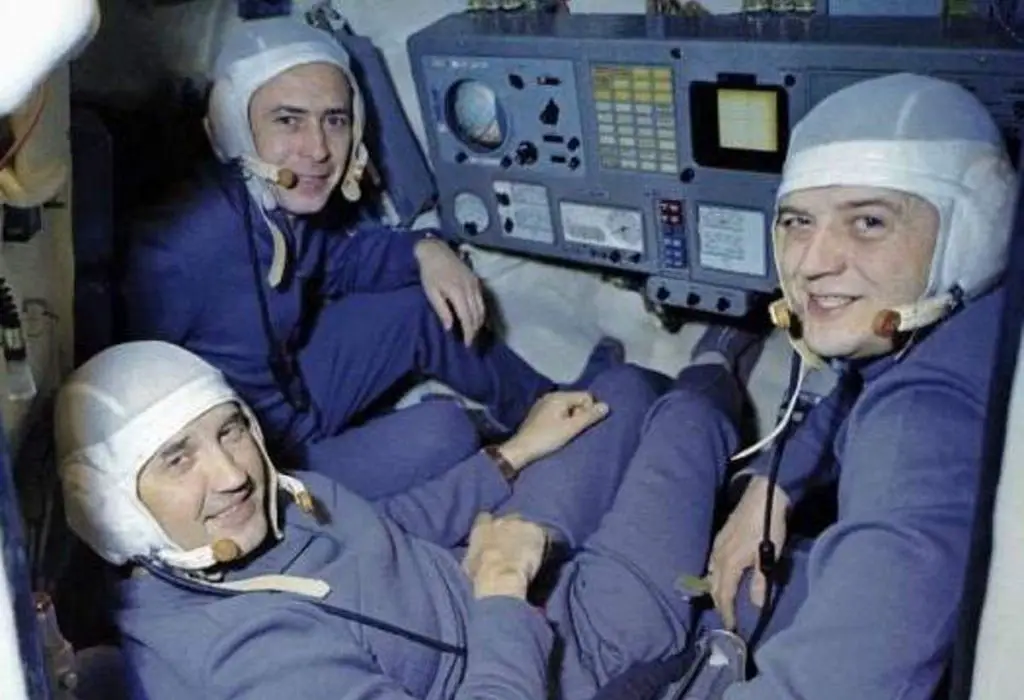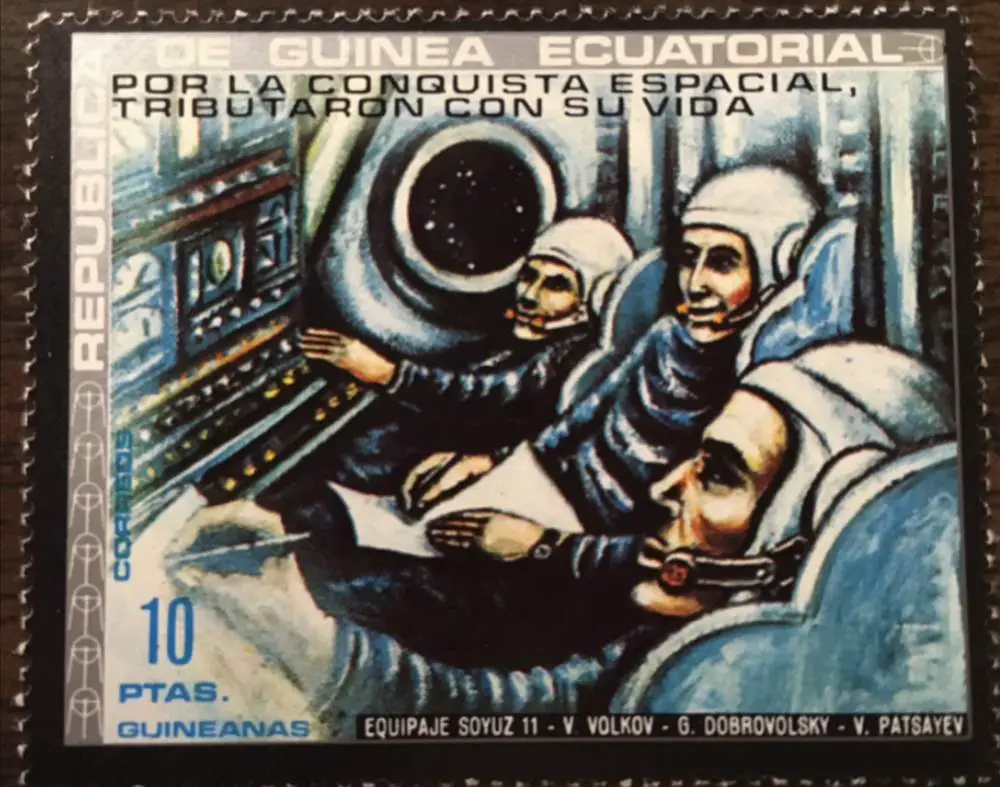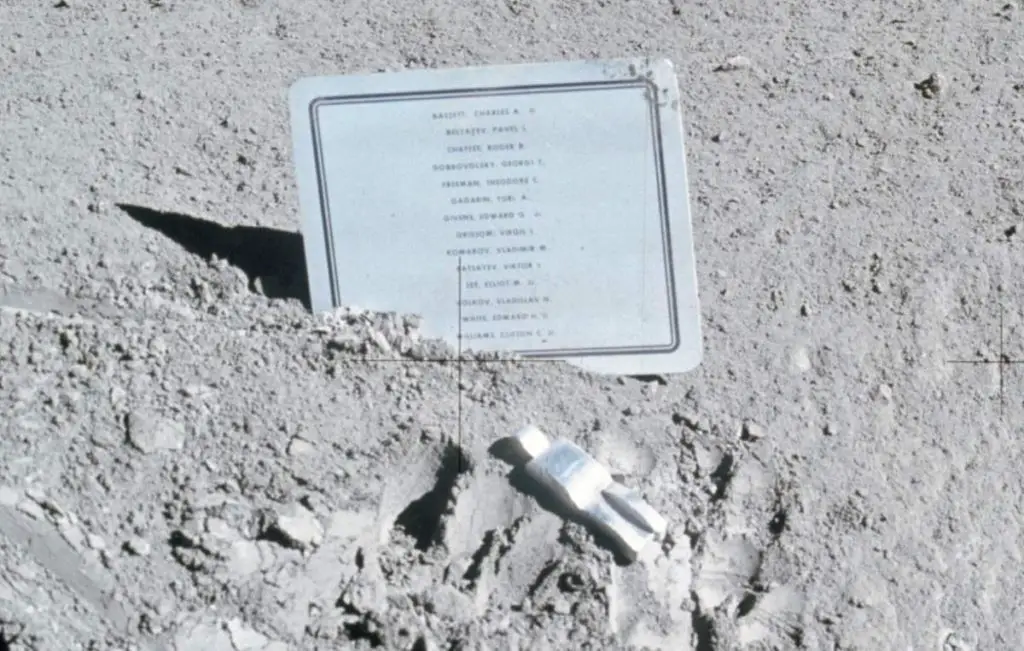On June 29, 1971, after completing its record-breaking 20th day in orbit, the crew of Soyuz 11, Georgy T. Dobrovolski (Commander), Viktor I. Patsayev, and Vladislav N. Volkov departed from the Salyut 1 space station, the first space station in the history of space exploration, on June 29, 1971. Unfortunately, the mission ended in disaster when the crew capsule depressurized during preparations for re-entry. The cosmonauts rapidly lost consciousness as the pressure continued to drop and died within two minutes.
Dobrovolski, Patsayev, and Volkov still remain the only humans to have died in space (above the Kármán Line, see notes 1).
Today’s (June 29) story of what happened this day in Science, Technology, Astronomy, and Space Exploration history.
Soyuz 11 disaster: Descending into a void
The only three humans who died in space
Soyuz 11 mission was launched on June 6, 1971, from Baikonur Cosmodrome in central Kazakh Soviet Socialist Republic. The Soyuz 7K-OKS spacecraft was piloted by Commander Georgy Timofeyevich Dobrovolski, Vladislav Nikolayevich Volkov was Flight Engineer, and Viktor Ivanovich Patsayev was the Research Engineer.
The callsign of the Soyuz 11 mission was Yantar (amber).
Soyuz 7K-OKS was the first spacecraft designed for space station flights. It had a new “probe and drogue” docking mechanism, which was first used by Soyuz 10 and Soyuz 11 missions. The mechanism featured an internal docking hatch that allowed for the first time internal transfer between Soviet spacecraft. This “probe and drogue” docking mechanism is still in use today at the International Space Station (ISS).
Soyuz 10 was the first mission to the Soviet Union’s Salyut 1 space station on April 23, 1971. But, a problem with the docking mechanism prevented the crew’s entry into the station, so the cosmonauts returned to Earth after two days.
The original prime crew for Soyuz 11 consisted of Alexei Leonov (the first spacewalker in the history of space exploration), Valeri Kubasov, and Pyotr Kolodin. The launch was scheduled to begin on June 6. But, just three days before the launch, during a preflight physical examination at the Baikonur Cosmodrome, doctors noted a dark spot on Kubasov’s chest X-ray. Worried that it might be tuberculosis, flight surgeons grounded Kubasov.
Reminiscent of the days prior to the Apollo 13 launch, which is widely cited as the “most successful failure in the history of space exploration”, managers debated whether to replace just Kubasov or all three cosmonauts with their backups. The operational rules also stated that the entire crew must be replaced.
Two days before launch, managers decided to replace the entire crew, backups Dobrovolski, Volkov (the only member of the crew with previous spaceflight experience), and Patsayev launched aboard Soyuz 11 on June 6.
Physicians later overturned Kubasov’s presumptive tuberculosis diagnosis.
Docking with Salyut 1 space station
Mission commander Dobrovolski flew Soyuz 11 to the Salyut 1 space station and on the next day after the launch, on June 7, he performed a manual docking without incident.

Three hours after docking, the equalization of pressure was completed. Patsayev floated into Salyut 1 and became the first human to enter a space station. He quickly noted a strong smell inside the space station, though, and returned to the Soyuz spacecraft.
Crew communicator Aleksei S. Yeliseyev advised the crew to turn on the station’s air regenerators and they did so. But, after the launch of Salyut 1, 6 out of 8 air regenerators of the space station had failed. So Patsayev and Volkov had to repair them first. After that, they returned to Soyuz to join Commander Dobrovolski and spent the night aboard Soyuz while regenerators are cleaning Salyut’s air.
Life aboard Salyut 1 space station
The next day, the crew of Soyuz 11 reentered Salyut 1. They activated the space station’s systems and powered down the Soyuz spacecraft. They would not need their spaceship until the end of their mission. Salyut 1 space station was 21.4 meters (70 feet) long with a total living space of 100 cubic meters (about 3,531 cubic feet), which gave the cosmonauts a place to conduct scientific experiments, relax, and sleep.

Three Soyuz 11 cosmonauts inhabited the space station over the next three weeks. They conducted scientific experiments, plus they exercised on Salyut 1’s onboard treadmill to counteract the effects of long-duration weightlessness and closely monitored their health state. Back then, there were still many unknowns about how the human body responds to the microgravity environment, especially during long-duration missions.
By operating the Orion-1 ultraviolet telescope, Patsayev became the first person to use a telescope in space.
The cosmonauts even grow vegetables: grew Chinese cabbage and onions in the Oazis-1 plant growth facility on the space station.
They also tested the condition of their cardiovascular system using a lower-body negative device called Veter. This device later became the Chibis apparatus used on subsequent Soviet and Russian space stations. It is still used today on the Russian segment of the International Space Station. They periodically measured their pulmonary function and drew blood samples for later analysis.
The crew slept in shifts, with at least one cosmonaut awake at all times and working. In doing so, they maximized the amount of research time. But, later, Soviet scientists concluded that these round-the-clock operations resulted in less than the optimum performance by the cosmonauts as it interfered with their sleep.

During the mission, the Soviet television broadcast the cosmonauts’ activities to the citizens. Soviet journalists dubbed the events Cosmovision.
Soyuz 11 cosmonauts also voted for the Soviet elections and became the first people to vote from space.
There were also incidents. On June 16, the crew responded to a small smoldering electrical fire at the rear of the station. The crew managed the control the fire just in time. Some temporary concern was raised that the mission might have to be curtailed because of the smoke caused by the fire, but the air cleaners of Salyut did their job and the mission continued. This incident was not publicized by the Soviet authorities at the time.
On June 19, Patsayev turned 38 and became the first person to celebrate a birthday in space. Dobrovolski and Volkov presented him with an onion and a lemon that Volkov had smuggled aboard their Soyuz 11 spacecraft.

Five days later, on June 24, Soyuz 11 crew broke the previous 18-day human spaceflight endurance record set by the Soyuz 9 crew in June 1970. One of Soyuz 9 cosmonauts, Andriyan Grigoryevich Nikolayev (5 September 1929 – 3 July 2004), serving as a spacecraft communicator, congratulated them on their accomplishment.
Over the next few days, the Soyuz 11 crew began preparations for their return to Earth, including preparing Salyut for a period of automated operations.
Goodbye, Yantar, till we see you soon on mother earth
Late on June 29, the crew reactivated their Soyuz spacecraft, and after packing film and samples for return to Earth, closed the hatch between Salyut and their return craft. An instrument panel light indicated that the hatch to their descent module had not sealed properly, and Yeliseyev walked the crew through a procedure to reopen the hatch and clean the seals of any foreign object that might be preventing a firm seal. Although the indicator light stayed on, ground control and the crew were convinced the hatch was properly sealed and the cosmonauts proceeded to undock their Soyuz from Salyut.
During a fly-around, the crew filmed and photographed the Salyut 1 space station, which was their home for more than three weeks.

Ground control radioed: “Good bye, Yantar, till we see you soon on mother earth.” Dobrovolski replied: “Thank you, be seeing you. I am starting orientation.”
After flying free for three orbits around the Earth, at 1:35 a.m, mission commander Dobrovolski oriented the Soyuz spacecraft so it was flying backwards and ignited its retrorocket for 187 seconds to slow it down for reentry.
Tragedy struck
Nine minutes after the end of the burn, at an altitude of about 80 miles (129 km), well above the Kármán line (100 km or 62 miles) explosive bolts separated the Soyuz into its three components, with the crew inside the middle bell-shaped descent module.
Just 30 minutes from landing, it was at this moment that tragedy struck.
The shock from the explosive bolts jarred open a pressure equalization valve that should normally be opened only once the spacecraft was descending on its parachute, well inside the Earth’s atmosphere.
But in this case, the spacecraft was still above the Kármán line, the valve opened to the vacuum and the capsule’s air escaped into space in less than one minute.
The cosmonauts were not wearing pressure suits.
There’s evidence the cosmonauts tried to respond to the emergency by manually closing the valve (Patsayev’s body was found positioned near it). But, unfortunately, it was a futile attempt because closing it manually was a process that took several minutes.
Three cosmonauts rapidly lost consciousness as the pressure continued to drop and died within two minutes.
But, ground control didn’t know anything about the incident. It was just happened so fast: within mere seconds, the cabin pressure was already fatal.
Meanwhile, the capsule continued its reentry in a fully automatic mode, the only concern raised on the ground being the lack of voice communication with the crew since they knew nothing about the pressure loss.
Soyuz’s parachute opened as planned and rescue helicopters touched down alongside the capsule as it made a soft landing 320 miles (515 km) east of the city of Zhezkazgan in Soviet Kazakhstan.
Recovery forces opened the hatch to find the lifeless bodies of the cosmonauts still strapped in their seats. Resuscitation efforts by rescue personnel proved ineffective.

The accident was a stunning blow to both the Soviet Union and the international aerospace community. Once again, the experimental and risky nature of humans’ venture into space had been made clear.
The Soviet government posthumously awarded Dobrovolski, Volkov, and Patsayev the Hero of the Soviet Union medal. The bodies of the three cosmonauts lay in state in flower-covered biers in Moscow’s Central House of the Soviet Army on July 1, with thousands of mourners filing past to pay their respects. After cremation, they were honored with a full state funeral on Red Square and their ashes interred in the Kremlin Wall.
President Richard M. Nixon issued the following statement following the tragedy:
The American people join in expressing to you and the Soviet people our deepest sympathy on the tragic deaths of the three Soviet cosmonauts. The whole world followed the exploits of these courageous explorers of the unknown and shares the anguish of their tragedy. But the achievements of cosmonauts Dobrovolski, Volkov and Patsayev remain. It will, I am sure, prove to have contributed greatly to the further achievements of the Soviet program for the exploration of space and thus to the widening of man’s horizons.
U.S President Nixon sent Apollo 10 astronaut Thomas P. Stafford (born September 17, 1930, one of 24 people who flew to the Moon) to represent him at the funeral where several cosmonauts including the first spacewalker Alexei Leonov and Georgi T. Beregovoi hosted him.
Less than two years later, the Americans and Soviets named Stafford and Leonov the respective commanders of the Apollo and Soyuz spacecraft that docked in orbit in July 1975 for the historic handshake in space. From that shared experience, the two developed a lifelong friendship.
In Memoriam
On August 2, 1971, exactly one month after the funeral for the Soyuz 11 cosmonauts, Apollo 15 astronauts David R. Scott and James B. Irwin deployed a plaque and a statuette at the Hadley-Apennine landing site on the Moon dedicated to fallen astronauts and cosmonauts, including Dobrovolski, Volkov, and Patsayev.

In 1973, the Soviet government built a monument to the Soyuz 11 crew on the exact spot of their landing in Kazakhstan.
Rarely visited in its remote location 16 miles from the nearest road, vandals destroyed it in 2008, carrying away the copper from which it was made. In 2016, Russian and Kazakh officials unveiled a new granite monument on the exact same spot, bearing the following inscription:
“The feat of the brave sons of the Soviet people, cosmonauts G.T. Dobrovolski, V.N. Volkov, V.I. Patsayev, committed in the name of the triumph of science, for the good of all mankind, will forever remain in the grateful memory of people all over the planet.”
Craters on the Moon are named after Dobrovolski, Volkov, and Patsayev, and the Soyuz Colles group of hills on Pluto honors their memory.
After the Soyuz 11 fatal incident, all future Soyuz spacecraft came equipped with sturdier valves featuring quick-action chokes that can quickly plug any air leaks. But, even more importantly, all future crews also don pressure suits intended for emergency use throughout both launch and landing.
Notes
- The Kármán line, or the Karman line, is an attempt to define a boundary between Earth’s atmosphere and outer space. There is no international law or agreement defining the edge of space: The Fédération Aéronautique Internationale (FAI), which is an international standard-setting and record-keeping body for aeronautics and astronautics, defines the Kármán line as the altitude of 100 km (62 miles; 330,000 feet) above Earth’s sea level. Other organizations do not use this definition. For instance, the US Air Force and NASA defines the limit to be 50 miles (80 km) above sea level for purposes of awarding personnel with outer space badges.

Related: Apollo 1 Tragedy [January 27, 1967]
Sources
- Soyuz 11 on Wikipedia
- Soyuz 11: Triumph and Tragedy on the NASA website
- Remembering the Crew of Soyuz 11 on the NASA website
- “The crew of Soyuz 11 during mission practice” on the NASA Starchild website
- Soyuz 11 mission information on the NASA Space Science Data Coordinated Archive website
- “Descent into the void (System Failure Case Studies)” on the NASA website (PDF)
- “Remembering the crew of Soyuz 11, the only astronauts to die in space” on Astronomy.com
- Moon Landings: All-Time List [1966-2025] - February 2, 2025
- What Is Max-Q and Why Is It Important During Rocket Launches? - January 16, 2025
- Top 10 Tallest Rockets Ever Launched [2025 Update] - January 16, 2025
